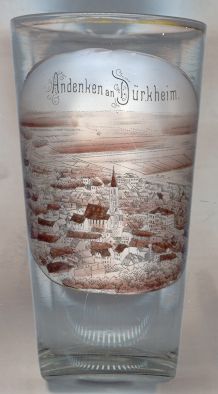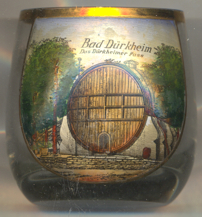

|
| DEUTSCHLAND | GERMANY |
| Bundesland: Rheinland-Pfalz | Rhineland-Palatinate |
| Landkreis: Bad Dürkheim |
 Bad Dürkheim is situated at an elevation of 132 m on the river Isenach in the western foothills of the
Pfälzer Wald region, about 30 km east of Kaiserslautern and 20 km west of
Mannheim. Bad Dürkheim is the seat of the administration of the district of the same name;
the municipality has a population of about 14,500 (2015).
Bad Dürkheim is situated at an elevation of 132 m on the river Isenach in the western foothills of the
Pfälzer Wald region, about 30 km east of Kaiserslautern and 20 km west of
Mannheim. Bad Dürkheim is the seat of the administration of the district of the same name;
the municipality has a population of about 14,500 (2015).
The earliest document mentioning Turnesheim is the Codex Laureshamensis (Lorsch Codex) of AD 778, another document mentioning Thuringesheim dates of AD 946. From 1025 it was in possession of the nearby Benedictine abbey Limburg (today in Bad Dürkheim) which gave it as a fief to the Counts of Leiningen in 1206. Already in 1360 Dürkheim was mentioned as a town, but lost this status in 1471 when it was conquered by Elector Friedrich I ('the Victorious') of the Palatinate. In 1554 the Counts of Leiningen-Dagsburg obtained full possession of Dürkheim. During the Palatinate War of Succession, Dürkheim was almost completely destroyed in 1689, but was rebuilt and obtained the status of a town again already in 1700. In 1725 it became the residence town of the Counts (1779 Princes) of Leiningen(-Dagsburg-Hardenburg) and remained their residence until 1794 when it was conquered by France. Like the rest of the Palatinate it became part of the Kingdom of Bavaria in 1816. The saline springs — already used for he production of salt as early as 1387 — became the basis for therapeutic applications of the saline in the 19th century. In 1847, Dürkheim obtained the official status of a spa town, and in 1904 received the predicate Bad. Today, Bad Dürkheim is one of the most popular spa towns in Germany's state of Rheinland-Pfalz.
The  Schlosskirche [centre], the church of the former residence, was built
in Gothic style between around 1300 and 1335 in place of an older, Romanesque church of around 1200.
The medieval west tower was heightened in 1865–1866. Restoration works in 1978 aimed at
restoring the original Gothic appearance of the church. The church houses the Renaissance burial chapel of the Counts of
Leiningen, dating from 1504–1508.
Schlosskirche [centre], the church of the former residence, was built
in Gothic style between around 1300 and 1335 in place of an older, Romanesque church of around 1200.
The medieval west tower was heightened in 1865–1866. Restoration works in 1978 aimed at
restoring the original Gothic appearance of the church. The church houses the Renaissance burial chapel of the Counts of
Leiningen, dating from 1504–1508.
 The
The  Giant Barrel (Dürkheimer Fass) [left] was built in 1934 by
the local wine-grower and cooper Fritz Keller in order to create a memorial to German wine. In the Black Forest, almost
200 pine trees, each about 40 metres high, were felled for this project. For each of the 178 barrel staves, which
were 15 meters long and 15 centimetres thick, a whole pine tree was needed. The barrel has a diameter of
13.5 metres and has a cubic capacity of 1.7 million litres. Becauce of the great number of visitors, in 1956
a rustic and original wine bar for approximately 120 guests, built in the style of the Giant Barrel, was added.
Giant Barrel (Dürkheimer Fass) [left] was built in 1934 by
the local wine-grower and cooper Fritz Keller in order to create a memorial to German wine. In the Black Forest, almost
200 pine trees, each about 40 metres high, were felled for this project. For each of the 178 barrel staves, which
were 15 meters long and 15 centimetres thick, a whole pine tree was needed. The barrel has a diameter of
13.5 metres and has a cubic capacity of 1.7 million litres. Becauce of the great number of visitors, in 1956
a rustic and original wine bar for approximately 120 guests, built in the style of the Giant Barrel, was added.
[https://de.wikipedia.org/wiki/Bad_Dürkheim; https://de.wikipedia.org/wiki/Schlosskirche_(Bad_Dürkheim),
http://www.duerkheimer-fass.de/index.php?id=79]
![[scale]](lineal.jpg)